In this article, we’ll explore the entropy mental model, its scientific foundations, and how you can apply it to improve your decision-making. You’ll also discover why “disorder is not a mistake; it is the default” and how this insight can help you work more effectively with the natural tendencies of systems rather than against them.
What Is Entropy? The Science Behind the Mental Model
Entropy explains why ice melts into water – a transition from an ordered state to a disordered one
Entropy is a concept that originated in thermodynamics, the branch of physics dealing with heat and energy. In its simplest form, entropy measures the degree of disorder or randomness in a system, often referred to as the order disorder dynamic.
The higher the entropy measure, the greater the disorder, aligning with the principles outlined in the second law of thermodynamics.
The concept was first introduced by Rudolf Clausius in the 1850s. He observed that heat always flows from hotter to colder objects, never the reverse. This observation led to the formulation of the Second Law of Thermodynamics, which states that “as one goes forward in time, the net entropy of any isolated or closed system will always increase or at least stay the same.”
In practical terms, entropy explains why:
- Ice cubes melt in your drink (from ordered solid to disordered liquid)
- Hot coffee cools to room temperature (heat energy disperses)
- Buildings deteriorate over time without maintenance
- Organized spaces become cluttered without intervention
The key insight is that disorder happens naturally, while order requires energy. Your house doesn’t clean itself—it takes effort to maintain order, which aligns with the concept of entropy.
This fundamental asymmetry, rooted in the second law of thermodynamics, shapes everything from physical systems to organizations and personal habits. The entropy measure illustrates how energy is needed to maintain order.
The Entropy Mental Model and Thermodynamics in Everyday Life

Recognizing the entropy mental model as a universal law of disorder helps us understand why maintaining order requires continuous input. This input can be effort, attention, or resources.
Understanding how entropy affects real systems bridges the gap between theoretical physics and practical decision-making. For example, a cluttered inbox is just as much a product of entropy as a decaying building. Both reflect the same underlying principle: without active maintenance, disorder wins.
Entropy as a Mental Model: A Framework for Understanding Change
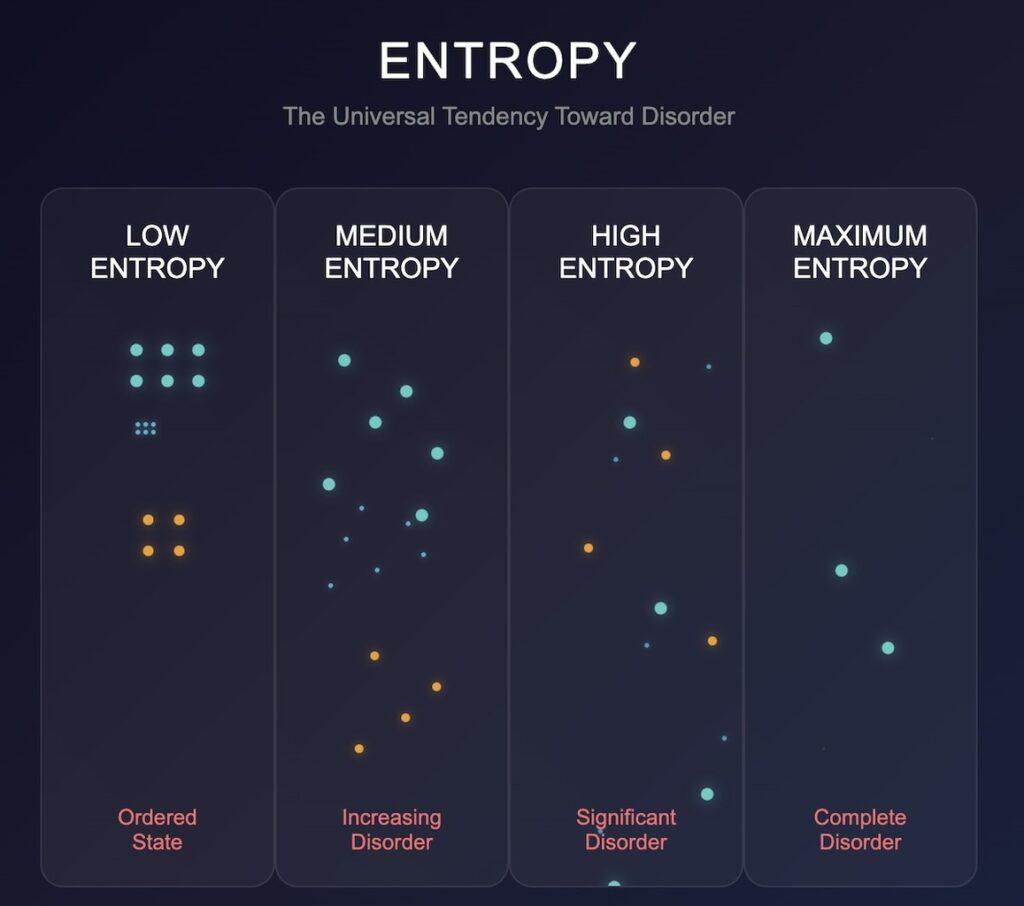
Entropy as a mental model applies to physical systems, workspaces, organizations, and relationships
James Gleick, in his book “The Information,” captures this beautifully: “Organisms organize… We sort the mail, build sand castles, solve jigsaw puzzles, separate wheat from chaff, rearrange chess pieces, collect stamps, alphabetize books, create symmetry, compose sonnets and sonatas, and put our rooms in order… It sometimes seems as if curbing entropy is our quixotic purpose in the universe.”
When applied as a mental model, entropy helps us understand:
The Natural Direction of Change
Systems naturally move from order to disorder. This isn’t a flaw—it’s the default state. Understanding this helps set realistic expectations and plan accordingly.
The Cost of Maintenance
Maintaining order requires continuous energy input. This explains why sustaining good habits, organized spaces, or efficient systems demands ongoing effort.
The Value of Structure
Creating systems and structures that minimize entropy can reduce the energy needed to maintain order, making sustainability more achievable.
The Inevitability of Decay
All systems eventually break down without intervention. This isn’t pessimistic—it’s realistic, and it helps us allocate resources appropriately.
Real-World Examples: Entropy in Action
The entropy mental model reveals itself in countless everyday situations. Let’s explore some concrete examples that demonstrate its practical relevance.
Organizational Entropy: Why Businesses Naturally Become Less Efficient
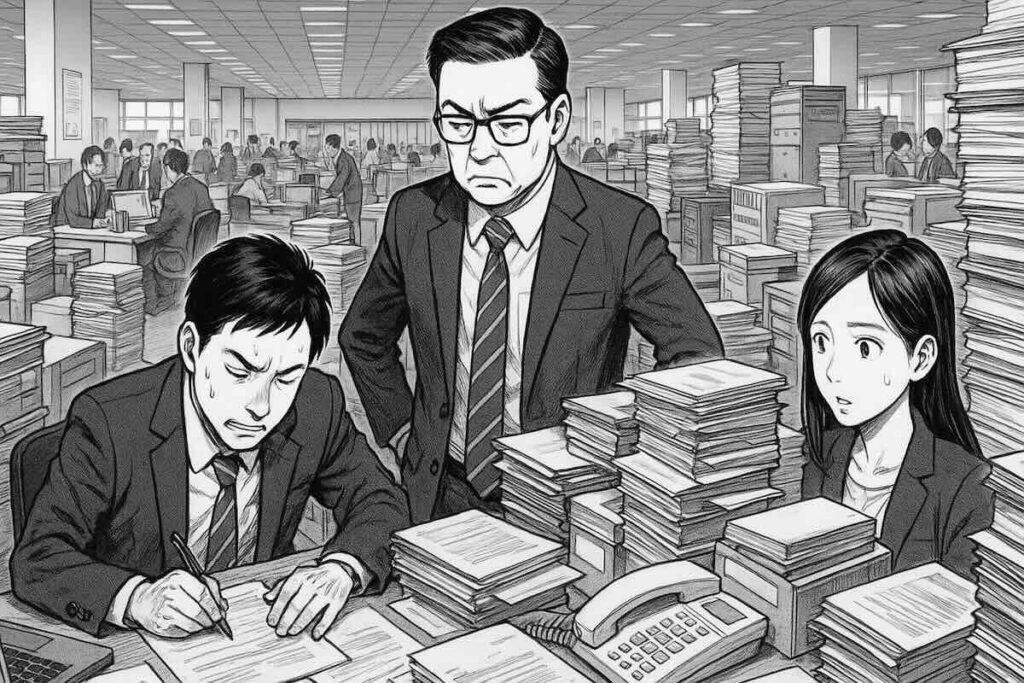
Organizational entropy: As companies grow, complexity and bureaucracy naturally increase without intervention
- Communication channels multiply and become tangled
- Decision-making processes grow more complex and slower
- Policies and procedures accumulate, often redundantly
- Organizational knowledge becomes fragmented and siloed
Successful organizations actively combat this entropy through regular process reviews, structural simplification, and intentional culture maintenance. According to the second law of thermodynamics, without this energy input, even the most streamlined organization will gradually drift toward disorder, as the number of complex structures increases and the force of entropy takes hold.
Personal Habits and Routines: The Entropy of Daily Life
Our personal lives are equally subject to entropy. Consider these common experiences:
- Exercise routines gradually fade without consistent commitment
- Healthy eating habits give way to convenient but less nutritious options
- Learning and skills deteriorate without practice (language fluency, musical ability)
- Relationships weaken without regular investment of time and attention
This explains why maintaining good habits requires continuous effort. The natural tendency is toward the path of least resistance—the higher entropy state. Understanding this helps us design better systems for maintaining positive behaviors.
Digital Entropy: The Chaos of Information
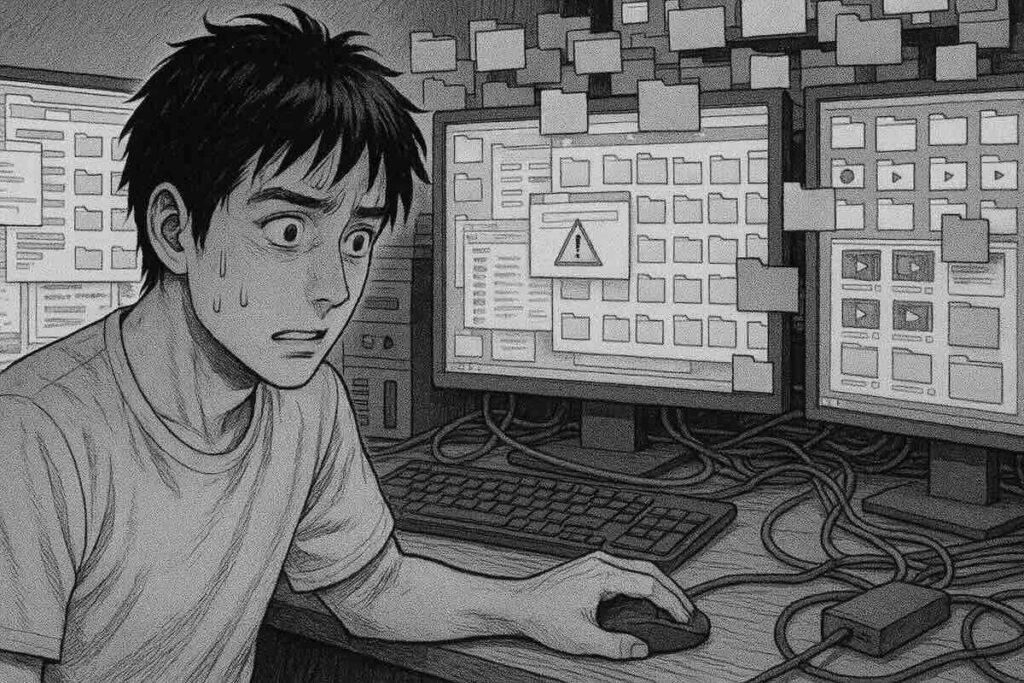
- Email inboxes that fill with unread messages
- Computer files that become disorganized without a consistent system
- Digital photos that accumulate without proper sorting or tagging
- Browser tabs that multiply until they overwhelm your system
Digital entropy is particularly challenging because the energy cost of digital clutter isn’t immediately apparent. Unlike a messy room that you have to navigate physically, digital disorder can accumulate behind the scenes until it suddenly impacts performance or findability.
Active vs. Passive Stability: A Key Entropy Insight
One of the most valuable insights from the entropy mental model is the distinction between active and passive stability states. Understanding this difference can help you design more resilient systems and measure their effectiveness, providing a clear example of how to avoid common pitfalls.
Passive Stability
Systems with passive stability can maintain order with minimal energy input. They’re designed to naturally resist disorder.
Examples:
- A well-designed sailboat that can weather a storm without intervention
- A balanced investment portfolio that automatically rebalances
- Sustainable ecological systems
Active Stability
Systems with active stability require constant energy input to maintain order. Without intervention, they quickly descend into chaos.
Examples:
- A fighter jet that needs constant computerized adjustments to fly
- A business that relies heavily on debt financing
- Most personal habits and routines
The trouble comes when we confuse these two types of stability. For example:
Many people treat relationships as if they have passive stability (assuming they’ll stay strong without effort), when in reality, relationships require active stability (regular attention and care).
Similarly, organizations often design processes that require active maintenance but fail to allocate the necessary resources to sustain them. Understanding which type of stability your systems have helps you allocate energy appropriately and avoid unexpected breakdowns.
Counteracting Entropy: Practical Strategies for Creating Order
While entropy is inevitable, we can develop strategies to counteract it efficiently. Here are practical approaches to managing entropy in different domains:
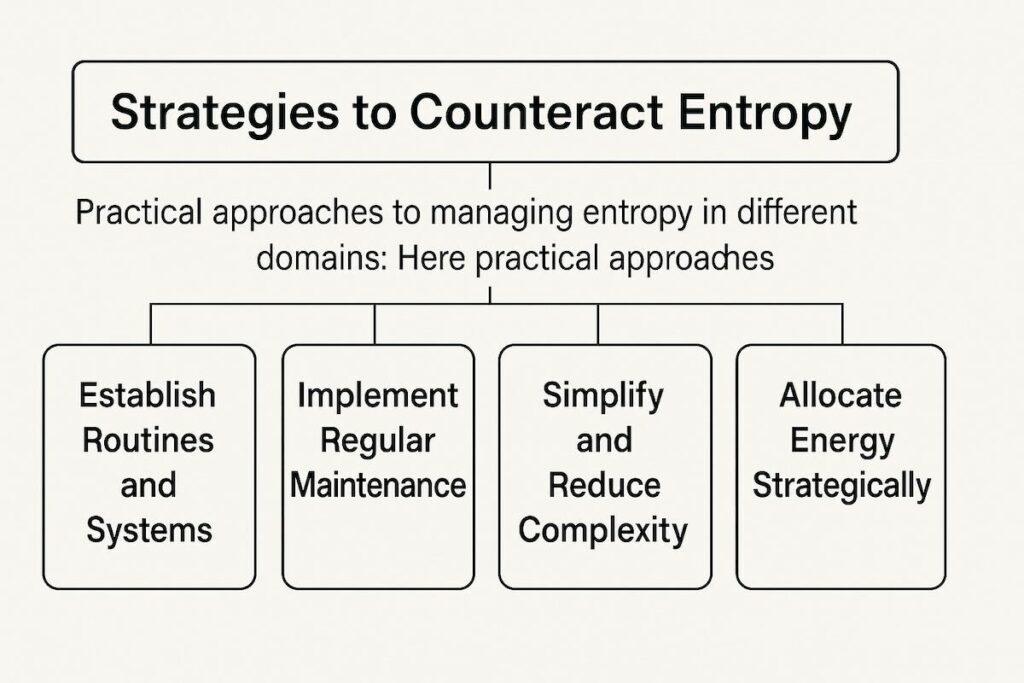
Practical strategies for counteracting entropy across different domains
1. Establish Routines and Systems
Creating consistent routines reduces the decision-making energy required to maintain order. By systematizing recurring tasks, you lower the energy barrier to maintaining order.
- Personal: Morning routines, exercise schedules, meal planning systems
- Professional: Standard operating procedures, project management frameworks, communication protocols
- Digital: File naming conventions, email processing workflows, automated backups
2. Implement Regular Maintenance
Scheduled maintenance prevents the accumulation of disorder and requires less total energy than major reorganizations after chaos has set in.
- Personal: Weekly review of goals, monthly decluttering sessions, quarterly life assessments
- Professional: Process audits, team retrospectives, regular training refreshers
- Digital: Regular inbox clearing, file organization sessions, device optimization
3. Simplify and Reduce Complexity
Simpler systems have fewer components that can become disordered, requiring less energy to maintain.
Simplifying systems reduces the energy required to maintain order
- Personal: Minimalism in possessions, focusing on fewer but deeper relationships
- Professional: Streamlining workflows, reducing unnecessary meetings, clarifying roles
- Digital: Using fewer apps, unsubscribing from newsletters, limiting social media accounts
4. Allocate Energy Strategically
Since we can’t fight entropy everywhere equally, prioritize where order matters most.
- Focus on high-leverage areas where order creates disproportionate benefits
- Accept higher entropy in low-impact areas to conserve energy
- Design for appropriate stability type (active vs. passive) based on importance
We cannot expect anything to stay the way we leave it. To maintain our health, relationships, careers, skills, knowledge, societies, and possessions requires never-ending effort and vigilance.
Energy Allocation: Where to Fight Entropy (and Where Not To)
Not all chaos needs to be conquered. It’s important to know where to put your energy. Focus on areas that really matter, like health, relationships, finances, or important systems.
Let less important areas, like sock drawers or unused folders, be a bit messy. This way, you save time on things that don’t really matter. The Pareto Principle helps here. Spend 80% of your time on the 20% of things that really count.
The Efficiency Principle: Getting More Order for Your Energy

Designing for Entropy: Building Resilient Systems That Last
Designing for entropy means accepting that disorder will happen. We build systems that can absorb it. Instead of aiming for perfection, we aim for resilience. A resilient system stays functional even as disorder increases.
This approach is used in many fields. In software engineering, fault-tolerant architecture keeps systems running even with failures. In project management, agile frameworks help teams adapt to changes. In health, routines like meal prep and workouts act as buffers against lifestyle disorder.
A key part of the entropy mental model is redundancy. We use backups, checklists, automation, and rituals to create structure. These aren’t inefficiencies—they’re tools to fight entropy.
The Impact of Existing Entropy
The same amount of energy creates different amounts of order depending on the current entropy level of the system. Consider this analogy:
A single cough in a quiet coffee shop (low entropy environment) creates a significant disruption. The same cough in Times Square (high entropy environment) has virtually no impact.
This principle applies broadly:
- Organizational change: The same improvement initiative will have more impact in a well-organized company than in a chaotic one
- Personal productivity: The same focus technique works better in a distraction-free environment than in a noisy, interruption-filled one
- Communication: The same message is more effective in a clear, consistent communication channel than in a cluttered one
Strategic Implications
This understanding leads to several strategic insights:
1. Reduce Entropy Before Making Changes
Clean up and organize a system before attempting to improve it. Your improvement efforts will be more efficient in a lower-entropy environment.
2. Choose Lower-Entropy Environments
When possible, operate in environments with less existing disorder. Your energy will create more value there.
3. Create Entropy Buffers
Design systems with margins of safety that can absorb some disorder without requiring immediate intervention.
4. Recognize Diminishing Returns
There’s a point where additional order-creating energy produces minimal benefits. Know when “good enough” is sufficient.
Common Misconceptions About Entropy
To effectively apply the entropy mental model, it’s important to avoid these common misconceptions:
Correct Understanding
- Entropy is a natural tendency, not an absolute law in all contexts
- Local entropy can decrease with energy input
- Some systems can be designed for lower entropy maintenance
- Entropy is about probability, not certainty
Misconceptions
- Entropy means everything is doomed to fail
- Fighting entropy is pointless
- All systems require the same energy to maintain
- Entropy increases at the same rate in all systems
The entropy mental model isn’t about fatalism or giving up in the face of inevitable disorder. Rather, it’s about understanding the natural tendencies of systems so we can work with them more effectively. It helps us allocate our limited energy wisely and design more sustainable systems.
Entropy Mental Model-Informed Decision Making

An entropy-informed decision-making framework helps evaluate options based on long-term sustainability
Evaluating Options Through the Entropy Lens
When facing decisions, consider these entropy-related factors:
- Maintenance requirements: How much ongoing energy will each option require to sustain?
- Stability type: Does the option create active or passive stability?
- Complexity impact: Will the option increase or decrease the overall complexity of your system?
- Failure modes: How gracefully will the option degrade when entropy inevitably increases?
Long-Term vs. Short-Term Thinking
Entropy naturally increases over time, making long-term considerations particularly important:
- Short-term efficiency often creates systems that are brittle in the long term
- Redundancy and slack, while seemingly inefficient, provide entropy buffers that increase resilience
- Simple, robust solutions often outperform complex, optimized ones as entropy increases
By incorporating entropy considerations into your decision-making process, you can create more sustainable systems and avoid the common pattern of short-term gains followed by long-term collapse due to accumulated disorder.
Related Mental Models That Interact with Entropy
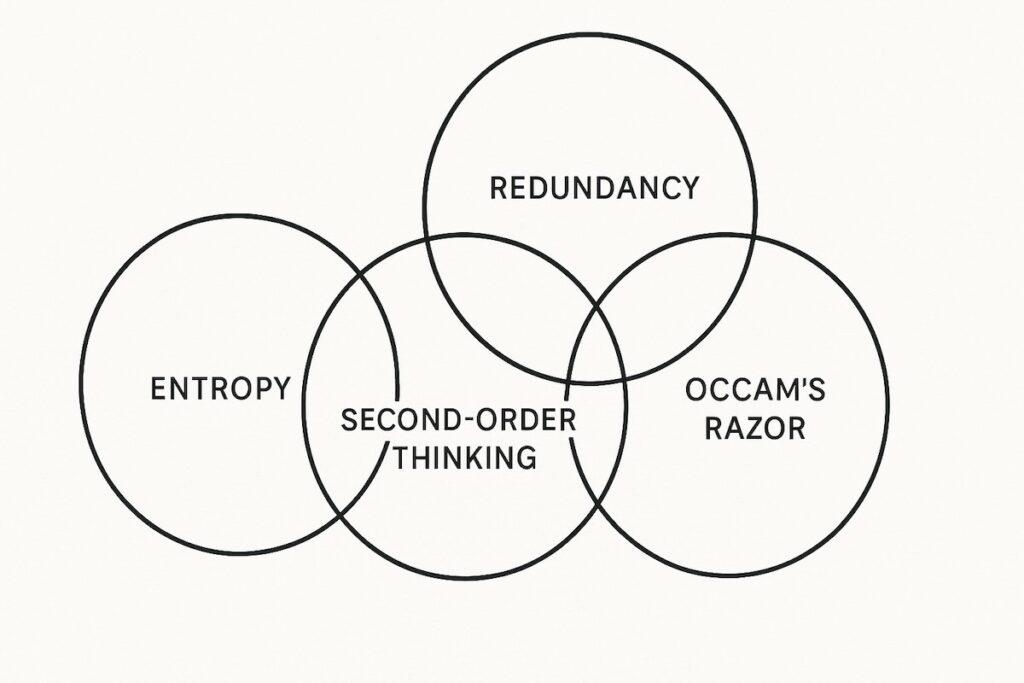
- Second-Order Thinking: Entropy reminds us to consider not just short-term outcomes, but how systems decay over time without reinforcement.
- Occam’s Razor: The simpler a system, the less entropy it accumulates. Complexity is entropy’s best friend.
- Redundancy & Margin of Safety (from Systems Thinking): These principles build buffers into your systems, reducing the impact of unexpected disorder.
Linking entropy with these frameworks strengthens your overall decision-making approach. It creates a layered understanding of both risk and resilience.
Conclusion: Embracing Entropy for Better Decisions
The entropy mental model offers a powerful framework for understanding why things naturally tend toward disorder and what we can do about it. By recognizing that “disorder is not a mistake; it is the default,” we can design more realistic strategies for creating and maintaining order in our lives, work, and systems.
Key takeaways from the entropy mental model include:
- Order requires energy to create and maintain
- Different systems require different types of stability (active vs. passive)
- Strategic simplification reduces the energy needed to fight entropy
- The same amount of energy creates different results depending on existing entropy levels
By applying these insights, you can make better decisions, create more sustainable systems, and allocate your limited energy more effectively. Rather than fighting against the natural tendency toward disorder, you can work with it, designing systems that require less energy to maintain and focusing your efforts where they’ll have the greatest impact.
The entropy mental model reminds us that maintaining order is a never-ending process—but with the right approach, it doesn’t have to be an exhausting one.


